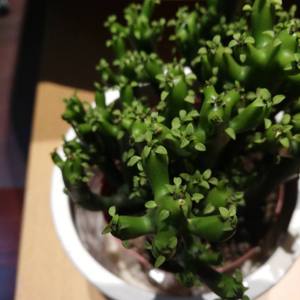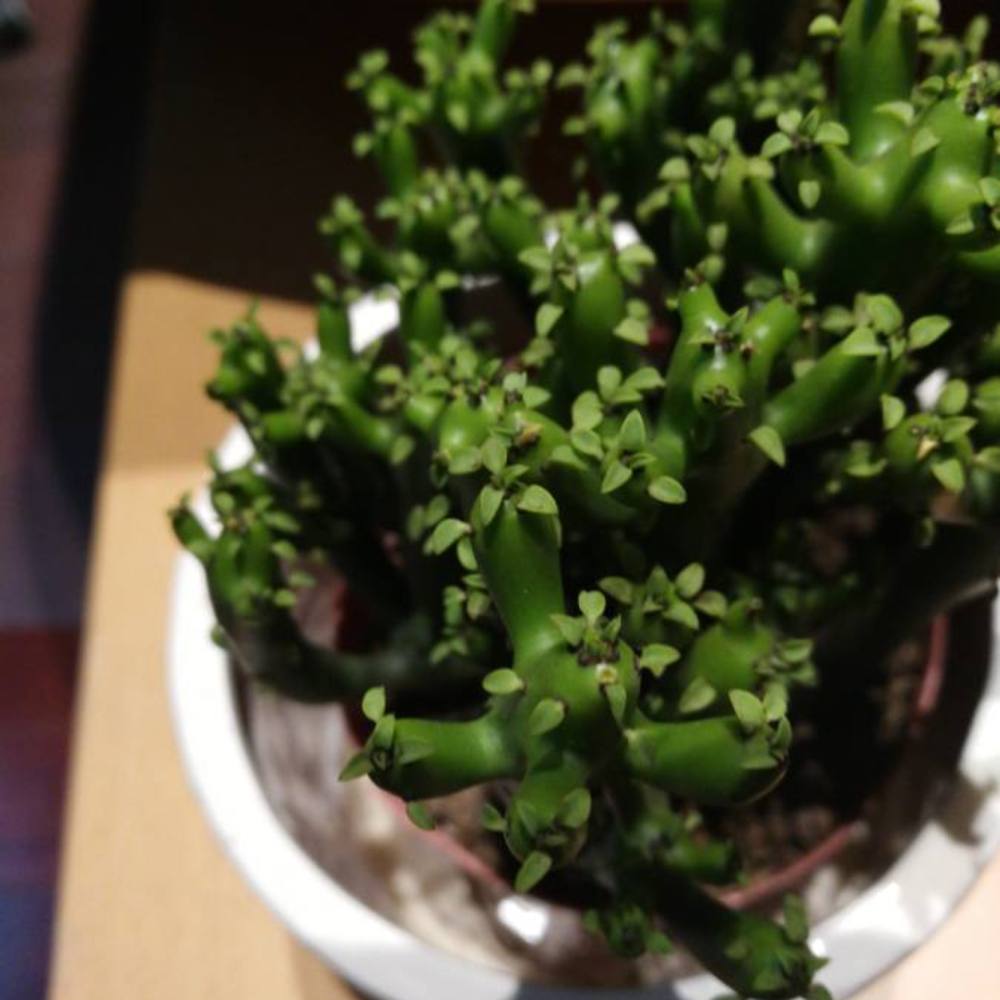Plant Experience
Detail
How to Grow a Pencil Tree (Euphorbia Tirucalli, 绿玉树)
@wikiHow
(https://m.wikihow.com/Grow-a-Pencil-Tree-(Euphorbia-Tirucalli)%3famp=1)
The Pencil Tree (Euphorbia tirucalli) is known by many names including stick plant, pencil cactus, milkbush, rubber euphorbia and fire sticks. This succulent shrub sprouts pencil-shaped branches and small leaves grow from the tips. This ornamental plant makes an unusual accent as a container plant or when planted as a small hedge. The pencil tree requires little maintenance, is drought tolerant and grows in poor soils. Be careful where you place this plant. Its milky sap irritates the skin and can be toxic when ingested. Learn more about growing this easy care plant with these easy how-to tips.
Part One of Five:
Selecting a Healthy Plant

1
Check the roots. When buying any potted plant from a nursery or garden center, gently life the plant out of the container and look at the roots. The plant should have these characteristics:
A firm but not compacted root ball.
White roots that do not show any signs of rot.
A dense cluster of roots that hold the soil.
Roots that extend to the edge of the container but do not circle around the inside of the container.

2
Look for healthy growth. Always choose the healthiest plant to be sure that you'll have years of enjoyment. Here are a few things you should look for in a Pencil Tree:
The plant should stand upright and not look wilted.
The color should be uniformly green, except on older plants where the trunk is brown and looks similar to bark.
The plant should be free of insects and plant damage.

3
Make sure the container is the right size.The Pencil Tree is a slow growing plant that can grow up to 5 feet (1.5 m) tall. Here are some tips:
Plants between 3 inches (7.6 cm) and 2 feet (61 cm) tall will grow in a 4 inches (10 cm) deep container.
Taller plants will do well in containers that are between 6 and 10 inches deep.
Part Two of Five:
Caring for a Pencil Tree

1
Allow the soil around the roots to dry out before watering. The Pencil Tree is drought tolerant and survives with infrequent watering. Areas with low rainfall are perfect for the Pencil Tree. When this plant gets too much water, the roots will rot.

2
Place the Pencil Tree in a location where it will get sun most of the day. The Pencil Tree tolerates a range a light conditions. The plant will thrive in areas with partial sun, filtered sunlight and full sun.

3
The Pencil Tree lives in poor soils. The Pencil Tree tolerates all types of soils.
Use a basic potting soil mix for container grown Pencil Trees.
In the landscape, the plant will grow in eroded soils, saline soils and other difficult growing conditions.

4
Don't worry too much about pests. The Pencil Tree is resistant to most pests and diseases. Most pests and diseases avoid the milky latex contained inside the stems. In wet and humid areas, the plant may suffer from stem and root rot.

5
Protect Pencil Trees from freezing temperatures. In the winter, the tips of the Pencil Tree may turn a reddish color. This is normal. During periods of freezing temperatures, the plant will need some protection.
Cover plants grown in the landscape with an old sheet. Place stakes around the plant and drape the sheet over the plant so that the sheet does not touch the plant.
Bring container-grown plants indoors or cover the plants with a sheet.
Part Three of Five:
Maintaining the Growing Plant

1
Support the plant as it grows. Small Pencil Trees may need some support as they begin to grow.
Insert a stick into the soil near the trunk of the plant.
Loosely tie the main stem (the trunk) to the stick.
Adjust the tie and the supporting stick as the plant grows.
Part Four of Five:
Pruning the Plant
1
Prune the Pencil Tree when it gets too large. As the Pencil Tree grows, prune the plant to keep it at a desired height.
Wear gloves to protect your hands from the milky latex.
Cut a stem near a point where the stem branches from the main branch.
Part Five of Five:
Propagating a Pencil Tree
1
Propagate the pruned off parts to make more Pencil Trees. The stems that were cut off when the plant was pruned can be placed in soil. These stems will grow roots and begin to grow. Here's how to propagate a Pencil Tree:
Plant the cut end of the stem in a small container of potting soil.
Water the soil so that the soil is soaked.
Allow the plant to slightly dry out (but not completely) while it is growing roots.
Community Q&A
How do I revive a pencil tree after leaving it freezing temperatures for a short period of time?
Answered by wikiHow Contributor
Why would you leave it in freezing temperatures? It says not to! Please, for the sake of the pencil tree, don't do that.
Warnings
Wear gloves when handling the Pencil Tree. The stems are filled with a milky latex that causes skin rashes and blisters.
Do not eat any part of the Pencil Tree. The milky substance inside the stems cause nausea, vomiting and diarrhea.
@wikiHow
(https://m.wikihow.com/Grow-a-Pencil-Tree-(Euphorbia-Tirucalli)%3famp=1)
The Pencil Tree (Euphorbia tirucalli) is known by many names including stick plant, pencil cactus, milkbush, rubber euphorbia and fire sticks. This succulent shrub sprouts pencil-shaped branches and small leaves grow from the tips. This ornamental plant makes an unusual accent as a container plant or when planted as a small hedge. The pencil tree requires little maintenance, is drought tolerant and grows in poor soils. Be careful where you place this plant. Its milky sap irritates the skin and can be toxic when ingested. Learn more about growing this easy care plant with these easy how-to tips.
Part One of Five:
Selecting a Healthy Plant

1
Check the roots. When buying any potted plant from a nursery or garden center, gently life the plant out of the container and look at the roots. The plant should have these characteristics:
A firm but not compacted root ball.
White roots that do not show any signs of rot.
A dense cluster of roots that hold the soil.
Roots that extend to the edge of the container but do not circle around the inside of the container.

2
Look for healthy growth. Always choose the healthiest plant to be sure that you'll have years of enjoyment. Here are a few things you should look for in a Pencil Tree:
The plant should stand upright and not look wilted.
The color should be uniformly green, except on older plants where the trunk is brown and looks similar to bark.
The plant should be free of insects and plant damage.

3
Make sure the container is the right size.The Pencil Tree is a slow growing plant that can grow up to 5 feet (1.5 m) tall. Here are some tips:
Plants between 3 inches (7.6 cm) and 2 feet (61 cm) tall will grow in a 4 inches (10 cm) deep container.
Taller plants will do well in containers that are between 6 and 10 inches deep.
Part Two of Five:
Caring for a Pencil Tree

1
Allow the soil around the roots to dry out before watering. The Pencil Tree is drought tolerant and survives with infrequent watering. Areas with low rainfall are perfect for the Pencil Tree. When this plant gets too much water, the roots will rot.

2
Place the Pencil Tree in a location where it will get sun most of the day. The Pencil Tree tolerates a range a light conditions. The plant will thrive in areas with partial sun, filtered sunlight and full sun.

3
The Pencil Tree lives in poor soils. The Pencil Tree tolerates all types of soils.
Use a basic potting soil mix for container grown Pencil Trees.
In the landscape, the plant will grow in eroded soils, saline soils and other difficult growing conditions.

4
Don't worry too much about pests. The Pencil Tree is resistant to most pests and diseases. Most pests and diseases avoid the milky latex contained inside the stems. In wet and humid areas, the plant may suffer from stem and root rot.

5
Protect Pencil Trees from freezing temperatures. In the winter, the tips of the Pencil Tree may turn a reddish color. This is normal. During periods of freezing temperatures, the plant will need some protection.
Cover plants grown in the landscape with an old sheet. Place stakes around the plant and drape the sheet over the plant so that the sheet does not touch the plant.
Bring container-grown plants indoors or cover the plants with a sheet.
Part Three of Five:
Maintaining the Growing Plant

1
Support the plant as it grows. Small Pencil Trees may need some support as they begin to grow.
Insert a stick into the soil near the trunk of the plant.
Loosely tie the main stem (the trunk) to the stick.
Adjust the tie and the supporting stick as the plant grows.
Part Four of Five:
Pruning the Plant
1
Prune the Pencil Tree when it gets too large. As the Pencil Tree grows, prune the plant to keep it at a desired height.
Wear gloves to protect your hands from the milky latex.
Cut a stem near a point where the stem branches from the main branch.
Part Five of Five:
Propagating a Pencil Tree
1
Propagate the pruned off parts to make more Pencil Trees. The stems that were cut off when the plant was pruned can be placed in soil. These stems will grow roots and begin to grow. Here's how to propagate a Pencil Tree:
Plant the cut end of the stem in a small container of potting soil.
Water the soil so that the soil is soaked.
Allow the plant to slightly dry out (but not completely) while it is growing roots.
Community Q&A
How do I revive a pencil tree after leaving it freezing temperatures for a short period of time?
Answered by wikiHow Contributor
Why would you leave it in freezing temperatures? It says not to! Please, for the sake of the pencil tree, don't do that.
Warnings
Wear gloves when handling the Pencil Tree. The stems are filled with a milky latex that causes skin rashes and blisters.
Do not eat any part of the Pencil Tree. The milky substance inside the stems cause nausea, vomiting and diarrhea.
Album (1)

my90ultimate
2018-06-20

This is my first growing diary.


Elite Article













